| Reviews & Columns |
|
Reviews DVD TV on DVD Blu-ray 4K UHD International DVDs In Theaters Reviews by Studio Video Games Features Collector Series DVDs Easter Egg Database Interviews DVD Talk Radio Feature Articles Columns Anime Talk DVD Savant Horror DVDs The M.O.D. Squad Art House HD Talk Silent DVD
|
DVD Talk Forum |
|
|
| Resources |
|
DVD Price Search Customer Service #'s RCE Info Links |
|
Columns
|
|
|
Stanley Kramer Film Collection
THE MOVIES:
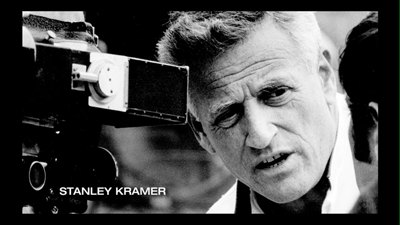
Stanley Kramer was a trailblazing independent producer who made nearly forty films, largely in the 1950s and 1960s. He worked with emerging talent like Marlon Brando, Lee Marvin, and George Segal, as well as established stars such as Vivien Leigh, Spencer Tracy, and Katharine Hepburn. He also directed, making two of the movies in this five-movie set himself.
The Stanley Kramer Film Collection spotlights the breadth of subject matter and passion that drove Kramer. He had a particular fire for tackling social issues, even when doing so in a somewhat exploitative manner, as in The Wild One. He also enjoyed personal dramas (The Member of the Wedding) and the whimsical (The 5,000 Fingers of Dr. T), and he even managed to put all three elements together in the Oscar-nominated Ship of Fools. This new six-DVD boxed set comes in celebration of the 40th anniversary of Guess Who's Coming to Dinner, and though a couple of these films have been available on DVD before, these are all brand-new packages, redesigned to fit the box and beefed up with extra features. Additionally, the sixth DVD is a supplemental disc to Dinner and is only available in this collection.
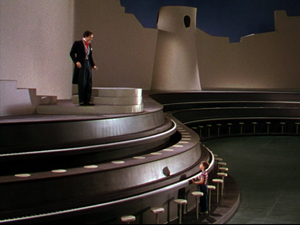
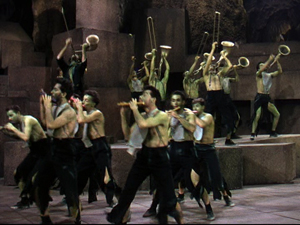
* The 5,000 Fingers of Dr. T (1952): For this early production effort, Kramer enlisted the burgeoning talent Dr. Seuss to pen a surreal children's story about a young boy, Bartholomew Collins (Tommy Rettig), who hates playing the piano so much, he dreams of a world where his piano teacher, the nefarious Dr. T (Hans Conreid), is starting an institute where he will enslave 500 young boys and force them to tickle the ivories 24-7. Not only does this dream take on the childhood anxiety of being stuck in a life of boredom, it also addresses Bart's familial loneliness, imagining the nice plumber (Peter Lind Hayes) who has been working in his home as a father figure who will rescue Bart and his widowed mother (Mary Healy) from a life alone.
More of a cult hit than a children's classic, the clunky 5,000 Fingers is most remembered for its enormous sets and bizarre villains, which bring Dr. Seuss visions to life in an overtly physical way. Made decades before digital effects, the gigantic locations were all built by hand, and it's fairly obvious. Watching the movie, you feel like you could reach in and pound your fist on the colorful walls. This gives the film a certain quaint charm that makes it possible to look past the barely-there story and wooden acting. Also of note is Hans Conreid, ever so delectable as the villain. He's largely familiar from Disney movies, particularly as the voice of Captain Hook in Peter Pan. It's a real treat to see him ham it up as the diabolical piano maestro.
Video/Sound: The 5,000 Fingers of Dr. T is a full frame feature in full color. The image is mostly clean, though the color is grainy at times, to the point of almost looking oversaturated.
The audio is basic stereo, but is mixed well and absent of any exterior hiss or tin-can sounds. As will be the pattern in this set, the movie has both English and French soundtracks, and both language tracks are subtitled, as well.
Extras: All the discs in The Stanley Kramer Film Collection include a short introduction by his wife Karen, whom Stanley was married to from 1966 until his death in 2001. These short but sweet video pieces set the scene for the movie, giving a small amount of background and noting where it appeared in Kramer's career history.
All the discs also have extra supplemental material specific to the movie. In addition to a photo gallery, 5,000 Fingers has two documentaries. "Dr. T on Screen" (14 minutes, 30 seconds) provides production background for the movie, and interviews contemporary critics as well as people related to the production. "A Little Nightmare Music" (11:45) enlists composer Michael Feinstein to discuss the unique score written for the movie by Seuss and Frederick Hollander.
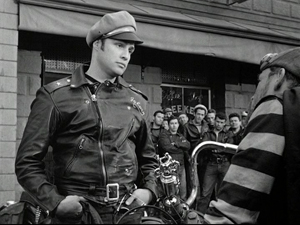
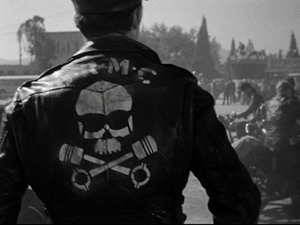
* The Wild One (1953): Essentially a B-picture with a faint whiff of a social conscience, The Wild One is still good for some cheap thrills, thanks almost entirely to the swaggering performance by Marlon Brando. Playing the self-possessed, laconic leader of a rowdy motorcycle gang, Brando's visceral acting style still electrifies the screen. Also a hoot-and-a-half is Lee Marvin as the head of a rival gang. If Brando is a prowling jungle cat, Marvin is the laughing hyena. It's the king vs. the clown.
The story of The Wild One is a competent genre screenplay, in some ways a Western on two-wheels. The gang rolls into a quiet town, runs afoul of the locals, and then terrorizes them until things go too far. Pushing the movie a little closer to the edge is the sexual threat inherent in Brando's performance. He has not only come to destroy America's way of life, but to take its favorite daughter--in this case played by Mary Murphy--away from the safe confines that she secretly yearns to break free of. At a lean 79 minutes, The Wild One speeds right by, but it's worth the rush.
Video/Sound: The Wild One is full frame, black-and-white. The picture is cleaned up nicely, with solid values for the darks and lights. The basic audio mix is equally clean, highlighting the motorcycle sound effects and keeping often complex crowd scenes sounding clear. English and French audio and subtitles.
Extras: In addition to the Karen Kramer video intro, there is a full-length audio commentary by historian Jeanine Basinger.
The documentary "Hollister, California: Bikers, Booze, and the Big Picture" (27:45) tells the story of the real biker gangs that emerged after WWII and the small California town where a motorcycle rally got out of hand. Eventually, this story got inflated into the script for The Wild One, and surviving members of the original club discuss the merits of fact vs. fiction.
"Brando: An Icon is Born" (18:40) celebrates the actor and the revolution he brought to movies in this role. Providing colorful commentary are actor Dennis Hopper and director Taylor Hackford (Ray).
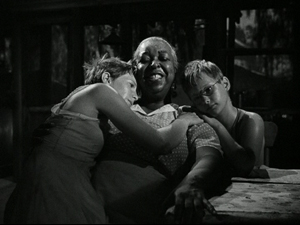
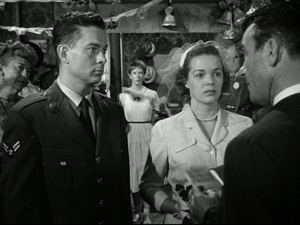
* The Member of the Wedding (1953): Based on a stageplay based on the novel by Carson McCullers, this film tells the story of Frankie (Julie Harris), a girl in her early adolescence wrestling with the world around her. Having suffered a growth spurt that makes her taller than the other kids her age, she is eager to achieve a level of maturity that matches her inches. When her brother (Arthur Franz) brings his fiancée (Nancy Gates) by for the family to meet, Frankie becomes smitten with them, uttering the famous line, "They are the we of me." She becomes convinced that she will go off and live with them after the wedding, blind to the harsh truth and heartbroken when it comes.
Most of the story revolves around Frankie spending time with her black maid Berenice (Ethel Waters) and her young cousin John Henry (Brandon De Wilde). They listen to her long verbal flights of fancy, the tales she spins being the only things that can match her in height. Harris is a dexterous performer, unloading the complicated monologues with ease while at the same time constantly moving, tossing around her bony limbs, spinning, and never pausing for even a syllable. Director Fred Zinneman (High Noon) keeps his shots small, sticking in close with his performers and managing to bring alive the feeling of oppressiveness and the unbearable heat that inspire Frankie to want to flee her troubled existence.
Video/Sound: Another full frame movie, the black-and-white print of The Member of the Wedding is excellent. There is good nuance here, with solid demarcations between the various shades of gray and very dark blacks. The audio is also very good, and there are subtitles in English and French.
Extras: Carson McCullers-biographer Virginia Spencer Carr has recorded an audio commentary for the movie, as well as the 15-minute documentary "The World of Carson McCullers." Between the two, we get a grander, expanded vision of the history of the story and how it related to the life of the author. The documentary also has plenty of behind-the-scenes pictures from the movie production.
Carr is also part of "The Journey from Stage to Film" (10 minutes), along with actor Kevin Spacey and Karen Kramer. It's an examination of the different worlds of stage and screen, how Kramer developed the work and how the main cast was the same as had made the stageplay a hit.
The final extras are the Karen Kramer introduction and the inexplicably short "note" from Julie Harris, where all she really says is that she had been in the stage version of The Member of the Wedding.
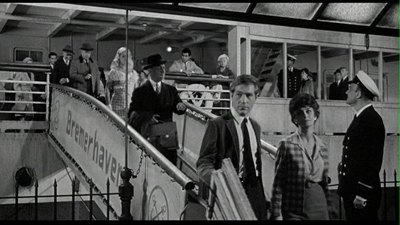
* Ship of Fools (1965): Stanley Kramer now steers the camera for real as the director in addition to being producer, and he steers a cruise liner full of a cross-section of society across the Atlantic toward 1933 Germany. Written by Abby Mann (Judgment at Nuremberg) from a novel by Katherine Anne Porter, Ship of Fools is a series of interlocked vignettes that travel the decks of the boat, showing the different levels of society, dissecting an international cast of characters. An Austrian anti-Semite philanderer (Jose Ferrer) rubs elbows with a deposed Spanish contessa (Simone Signoret), an alcoholic ex-baseball player (Lee Marvin), an idealistic but naïve painter (George Segal), a lonely middle-aged woman (Vivien Leigh), and many others. Each has their own shortcomings, usually enflamed by their shortsightedness, and putting them together, trapping them in one space for a specific period of time, only serves to call more attention to what ails them. Video/Sound: This is the first widescreen title in the set, and the black-and-white picture is as well handled here as in the previous films. Nice values, no artifacting or edge enhancement, and good blacks. I don't know how this compares to the earlier DVD release of this movie, but on its own, it's very good and certainly not a downgrade. Audio options are English and French, as are the subtitles. Extras: A photo gallery and the Karen Kramer introduction sit next to two new documentaries. "On Board the Ship of Fools" is a 28-minute feature with Karen Kramer and actors George Segal, Barbara Luna, and Elizabeth Ashley, all of whom were getting one of their earliest breaks in Ship of Fools. They discuss their characters and where they fit into the production. Abby Mann's writing is given tribute, as is the editing of Robert C. Jones, who is briefly interviewed. Alec Baldwin also appears to discuss his appreciation of the movie. The second documentary, "Voyage on a Soundstage," is 11 minutes and focuses on the complicated shooting of the film and the cinematography of Ernest Laszlo. Marshall Schlom, the movie's script supervisor, and noted cinematographer Laszlo Kovac (Easy Rider), who knew Ernest Laszlo, are interviewed. * Guess Who's Coming to Dinner (1967): The best movie in the lot, and the bonafide classic that is the impetus for this collection being brought together, Guess Who's Coming to Dinner endures because even 40 years on, it still comes across as smart and daring. A movie about ideas as much as it is about family drama, it avoids being overzealous in its message by weaving the debate through a very real narrative. Director/producer Stanley Kramer and writer William Rose put their words in the mouths of three-dimensional characters and let their communication drive the story. The premise of Guess Who's Coming to Dinner is that a young couple are coming home from the Hawaiian vacation where they met to tell her parents that they are getting married. The catch is that the girl, Joanna (Katharine Houghton), is white and the man, Dr. John Prentice (Sidney Poitier), is black. In 1967, this would be quite a shock for any parents, including Joanna's notoriously liberal ones. Played by Katharine Hepburn and Spencer Tracy, much of the pathos of the movie rides on their shoulders. It's their reactions that are going to make the philosophy and ethics of the scenario seem real. It's easy to believe two young people are in love, it's a whole other thing to see the people around them be daring enough to encourage their daring. This is where Kramer and Rose get it right, by not letting these characters be completely right or make all of the proper decisions. Ideas are ideas, but until they are challenged, we don't know how firmly we believe them. Over the single night that John and Joanna have before he has to fly on to Geneva, everyone the couple encounters--including other African Americans--will have to ask themselves exactly how they feel. For my money, Spencer Tracy is the man to watch here. I've always liked him, and in his final film role, the 67-year-old actor is just as fierce an orator as he always was (including in the Kramer-directed Inherit the Wind, a personal favorite of mine). The climax of the film hinges on a final, stirring monologue from Tracy, and despite his poor health, the legend still has all of his faculties. It's a moving speech, full of righteous fire. They just don't make them like Spencer Tracy anymore, do they? Funnily enough, for all of the progressive social issues, the parts of Guess Who's Coming to Dinner that now feel hilariously dated are the representations of the generation gap. Dig that crazy rock 'n' roll, daddy-o! Video/Sound: In full color and fully widescreen, this new DVD is a fabulous looking transfer. Rich pigments and a clean surface image. The sound options are upgraded from the other discs, and in addition to French and English audio and subtitle tracks, there is also Spanish audio and subtitles. Extras: Disc 1 has four video introductions: Karen Kramer, Steven Spielberg, Tom Brokaw, and Quincy Jones. Disc 2 has quite a few bonus features that are only available in this set. In addition to longer features, this includes a photo gallery and two video segments devoted to awards related to the film. One is Stanley Kramer accepting the Irving Thalberg Award in 1961, honoring his special achievements in filmmaking. The second is an award in honor of Kramer's social message being given to Al Gore in 2007. There are three documentaries to go with this. Two are specific to the movie: "A Love Story for Today" (29:45) and "A Special Kind of Love" (17:15) The first is specific to the enduring message of the movie and the way the conscious-driven production came together, and it features actress Katharine Houghton, actor Will Mead, Sidney Poitier's agent Martin Baum, editor Robert Jones, script supervisor Martin Schlom and admirers Louis Gossett, Garry Marshall, Norman Jewison, author Salome Thomas-El, and critic Joe Morgenstern. There is also archival interview footage with Stanley Kramer. "A Special Kind of Love" is a tribute to Tracy and Hepburn, and features old audio of the actress talking about the film. The movie was very much a family affair, as Houghton is also Hepburn's niece. The interviews featured are from the same sessions as "A Love Story for Today." The third is a too-short tribute to the man whose name graces the box: "Stanley Kramer: A Man's Search for Truth" (16:45). Gathered up from the other pieces to talk about the maverick filmmaker are Norman Jewison, Dick Van Dyke, Beau Bridges, Dennis Hopper, Garry Marshall, Karen Kramer, Alec Baldwin, Louis Gossett, and Taylor Hackford, and they sit alongside Kramer's own words. I just wish we had been given more time to learn about this fascinating man, who was a tenacious independent and a pioneer. A feature-length biography would have been even more welcome. THE DVD Packaging There is also a single-sheet insert that has the film summaries and a special note about Stanley Kramer from Karen Kramer. FINAL THOUGHTS:
Jamie S. Rich is a novelist and comic book writer. He is best known for his collaborations with Joelle Jones, including the hardboiled crime comic book You Have Killed Me, the challenging romance 12 Reasons Why I Love Her, and the 2007 prose novel Have You Seen the Horizon Lately?, for which Jones did the cover. All three were published by Oni Press. His most recent projects include the futuristic romance A Boy and a Girl with Natalie Nourigat; Archer Coe and the Thousand Natural Shocks, a loopy crime tale drawn by Dan Christensen; and the horror miniseries Madame Frankenstein, a collaboration with Megan Levens. Follow Rich's blog at Confessions123.com.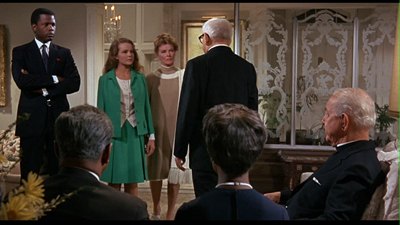

The Stanley Kramer Film Collection comes in a sturdy box. The DVDs sit together on three double-disc trays that fold together to form a "book," and a leaf in the book is give for each set of two DVDs. The book itself is decorated with photos and lists the special features on each disc. When folded, it fits inside an outer slipcase.
The Stanley Kramer Film Collection is a solid representation of a man who spent his career attempting to push the boundaries of filmmaking by telling human stories that didn't flinch in the face of grander social issues. Be it adolescent fury, racism, or just the way human beings can get under each other's skin and do damage, Kramer the producer tried to tell real stories about real people. Sometimes he strayed a little off the mark, such as the more exploitative elements of The Wild One, but even the odd duck Seussical The 5,000 Fingers of Dr. T tries to plumb the depths of childhood fears, no matter how whimsical the presentation. He also sticks to his most common theme of respecting what is different in each and every one of us. As a director, though, Kramer really put it on the line, using movies like Ship of Fools and Guess Who's Coming to Dinner to try to remove the taboo from important subjects. For those movies alone, The Stanley Kramer Film Collection is worth it, but all five films have something to recommend them. Plus, a well-designed package and a strong selection of extras make the boxed set Highly Recommended. 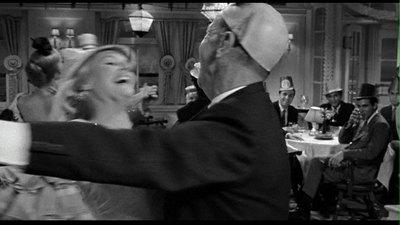
|
| Popular Reviews |
| Sponsored Links |
|
|
| Sponsored Links |
|
|
| Release List | Reviews | Shop | Newsletter | Forum | DVD Giveaways | Blu-Ray | Advertise |
|
Copyright 2024 DVDTalk.com All Rights Reserved. Legal Info, Privacy Policy, Terms of Use,
Manage Preferences,
Your Privacy Choices | |||||||












